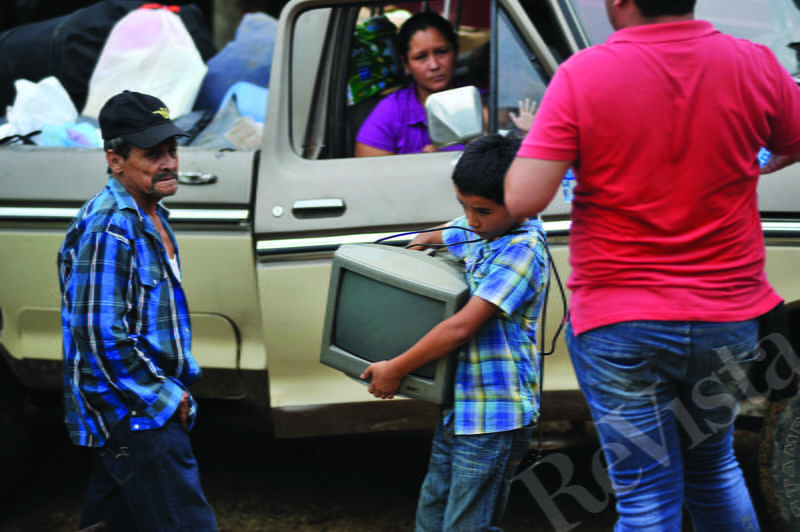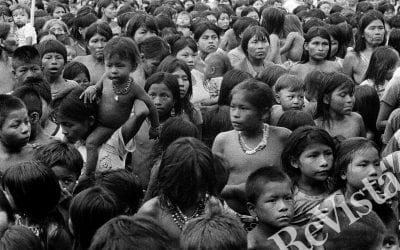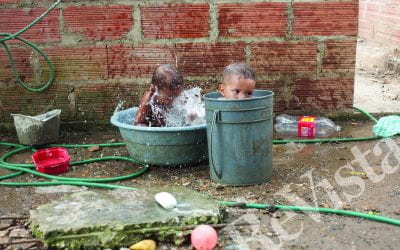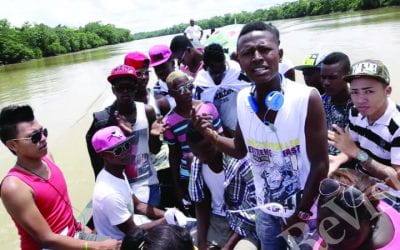Urban Spaces of Internal Displacement in Mexico
Reproducing Inequalities
When news came that the drug dealer Joaquín Guzmán, El Chapo, had escaped from a Mexican prison on July 2015, memories about cocaine cartels and urban gangs creating havoc in Colombia came quickly to mind. The tunnel that El Chapo used to escape, the exceptional conditions of his prison cell and the very capacity to coordinate an escape while in the custody of the Mexican authorities, were reminiscent of La Catedral the prison where Colombian drug dealer Pablo Escobar spent a little more than a year before he escaped in 1992. Such events often inspire movies and telenovelas because they spark the imagination of the public; they also tend to fade quickly, disappearing under other exciting news. The impact that the drug business has on the communities displaced by its criminal violence and on the physical and social fabric of cities, however, is largely overlooked.
The perfect climatic conditions and lush terrain of the mountainous region of Sierra Madre in Sinaloa, Mexico, have made it an ideal site for opium poppy and marijuana production. This is where El Chapo’s Sinaloa cartel have flourished together with the ongoing violence of its drug industry, leading to counter-violent tactics of government forces and to the mass of the ones trying to avoid it. Since the start of the Mexican Drug War in 2006, tens of thousands of people have been affected and displaced by violence. According to Mexican government statistics, 47,000 people were killed as a result of this intense violence, while other estimates put the figure at 100,000 in 2015. Displacement of civilians was also a significant result of the drug war in Mexico; according to the Internal Displacement Monitoring Centre (IDMC), 123,000 people were internally displaced in 2010, a number that has increased steadily, reaching 287,400 in 2015 (see Internal Displacement Monitoring Centre, http://www.internal-displacement.org/database/country/?iso3=MEX ,accessed November 10, 2016). In environments with much criminal violence, people are made to move for multiple reasons—direct physical threats, deterioration in the quality of life and shrinking livelihoods. Overall, the number of people leaving violent municipalities in Mexico is four to five times higher than that of those leaving non-violent municipalities with similar socio-economic conditions.
Drug cartel violence in Mexico created a de facto humanitarian crisis; this is a non-international armed conflict that meets most of the criteria of the International Humanitarian Law even though its armed forces are not motivated by an ideology or a political agenda. Yet neither the Mexican government nor the international humanitarian agencies have fully acknowledged this crisis of mass displacement. No mechanisms exist to support the forcibly displaced populations, who are left to manage on their own in new environments in which they are exposed to new difficulties, risks and threats.
Many reports on displacement in Mexico and other parts of Latin America focus on a wide range of socioeconomic issues. For example, displaced poor rural communities tend to suffer more drastically than the urban population; the rural poor often lose the land that provides their sustenance. Once displaced, they find it difficult to find work—especially those who end up squatting on the outskirts of cities. These are important issues, yet while forced displacement is also fundamentally a spatial issue, questions about the spaces related to this displacement are left unattended. Where, and in what conditions, do Internally Displaced People (IDP) live? What is the socio-political meaning of these new spaces of displacement?
Global Spaces of Displacement
More than 65 million displaced people worldwide find refuge in various types of spaces such as camps and urban areas. Whether displaced globally or internally, some of the forcibly displaced people live in refugee camps, where their basic needs are provided by governments, humanitarian agencies or non-profit organizations. These camps, meant to provide care and control, too often become spaces of neglect and violence, where people’s lives are suspended in a state of enduring temporariness for years and sometimes for generations. However, as the world becomes urbanized, we increasingly see the urbanization of refuge; currently more than sixty percent of the world’s displaced people live in cities, many of them in informal urban settlements.
While internally displaced people in Latin American cities form an integral part of the broader global politics and practices of urban informality and its ever-changing relationships, the urban spaces which they occupy and use also have specific characteristics and meaning in which old and new local, national and continental politics of race and violence become inseparable.
Urban Spaces of Displacement in Mexico
Recent studies in Mexico and other Latin American nations show that the settlements formed by internally displaced people, in and on the outskirts of cities such as Culiacán, the capital of Sinaloa state, have a greater tendency to become insecure, and often violent. These settlements are occupied by people from different rural origins, who often do not know one another and resent living in conditions of deprivation alongside the urban poor, who are city-savvy. Unable to get and retain formal jobs, feeling unsupported by the state, and under threat from urban residents, displaced groups form ethno-regional alliances for self-protection. Thus, mutually defensive groups regard each other with suspicion and distrust, which causes urban public spaces to be perceived as dangerous and, therefore, uninhabitable. Violence breeds more violence just in the same way that the various forms of social exclusion that are at stake in these conditions exacerbate segregation.
The effects of internal displacement in Mexico and Latin America and its never-ending cycles of violence have brought important questions to the political agenda. The question of racism has re-emerged, along with debates about marginalization as a systemic condition of inequity that allows the perpetuation of a system of political control and economic exploitation. The fact that statistically most displaced people in Mexico (indeed, in other countries in Central and South America too), the rural poor, are indigenous, mixed-race or Afro-descendants is striking evidence that there exist sustained modes of systemic marginalization. Similarly, discussions about colonialism, which had been largely avoided by Latin American intellectuals, now occupy centre stage in academic debates, revealing the colonial origin of contemporary patterns of racial exclusion.
Racial exclusionary patterns reappear in the geographies of racial distribution in most Latin American cities. Since the foundation of cities in the 16th and 17th centuries, black and indigenous populations have occupied different geographical positions from the colonizer’s centrality. That is why the conditions of exclusion and marginality that we see today in most Latin American cities are magnified expressions of a pattern of urban growth initiated by the Spanish and Portuguese with their segregationist approach to urban planning during the colonial period. It is no coincidence that these two socio-ethnic groups, black and indigenous populations, remain poor, under-represented and excluded from the dominant economic system, and they are the main victims of drugs, guerrilla and paramilitary conflicts throughout Latin America. As such, these are the population groups which are mostly displaced and their consequential urban resettlement patterns sustain the colonial ones.
The urban spaces of displacement in Latin American cities are therefore not merely the backdrop to the lives of the internally displaced people. Rather, their conditions of insecurity, uncertain economic and legal status in their new location, as well as the inability, or unwillingness, of the authorities to deal with the problem, reflect a situation of fundamental inequality and neglect which is deeply embedded in the colonial origins of politics in Latin America, including spatial politics. By reproducing the old patterns of race-based discriminatory divisions in cities, these new urban spaces of internal displacement form contested sites of political struggles which are grounded at the very core of their societies. The city itself indeed does offer a sanctuary to the internally displaced; however, the urban forms of welcoming clearly tend to be highly conditional and repeat segregating patterns which limit opportunities and maintain violent relations.
Where, and in what conditions, internally displaced people live is not a question that can be answered simply by summarising statistics or by looking at the provision of basic services such as schools, medical support and adequate housing in the settlements they occupy. Nor is it simply a matter of poverty alleviation through income generating initiatives. The underlying social and political issues are more complex and surpass the superficiality of this kind of simplistic approach. Can internally displaced people occupy other areas of the city? Can they receive increased humanitarian support? Can internally displaced people attain greater political representation? Space refers to a physical (geographical) as well as an intangible (socio-political) position, both of which influence the conditions of life for everyone in the city. The new urban environments of those displaced by violence seem to continue the cycle of violence and reproduce it in other spaces and forms, rather than offering support, assistance and comfort for the ones escaping it.
Winter 2017, Volume XVI, Number 2
Felipe Hernández an architect and a Senior Lecturer at the Department of Architecture University of Cambridge, has published extensively on Latin America. He is Chair of Cities South of Cancer, a research group working on urban issues in Colombia, Mexico, Argentina, Bangladesh and Indonesia.
Irit Katz is an architect and a researcher at the Department of Architecture University of Cambridge. She studies the spatial, social and geopolitical aspects of migrant camps, refugee camps and other spaces of displacement in historical and contemporary contexts.
Related Articles
Displacements: Editor’s Letter
The sweet pure tones of a violin emanated through my grade school auditorium. Ten-year- old Florika, a refugee after the 1956 Hungarian Revolution, was turning the warmth of once- living wood into a powerful source of communication. Florika spoke no English…
36 Hours (and More) in Cartagena
I arrived in Colombia in August 2014 on a Fulbright grant to research La Liga de Mujeres Desplazadas (The League of Displaced Women), an organization formed in the late 90s in…
Voices from the Atrato River
A traditional panga boat with thirty passengers cruises the mighty waters of the Atrato River in the Pacific region of Colombia, doing a 142-mile route from Quibdó to…





